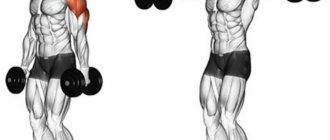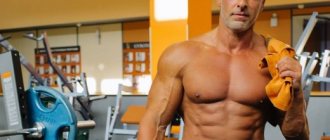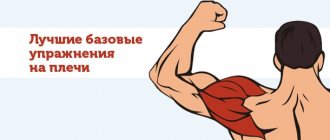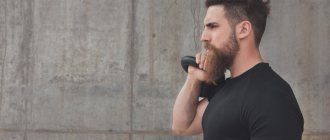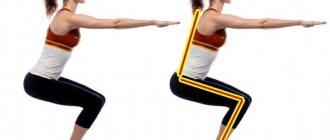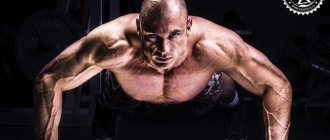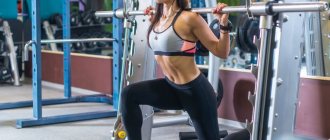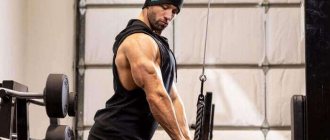Author of the article
Andrey Belozertsev
Drawing up programs for effective muscle mass gain.
To effectively and quickly pump up your shoulders and back, you need to adhere to a certain training schedule, as well as perform special exercises that will help increase the muscle mass of this particular muscle group.
Your back and shoulders should be trained regularly and with a weight that suits you individually.
In this article we will tell you how to properly strengthen your back and shoulders at home and in the gym using various exercises.
Several training programs proposed in this article will help you decide which exercises you can use to pump up your deltoids.
Each of the complex shoulder exercises will help pump up the entire shoulder girdle and all the deltoid muscle bundles.
What muscles to pump
The human body consists of a large number of muscles. The main ones are the chest, back, shoulders, legs, arms and abs.
Each of them contains many auxiliary muscles that are involved in working with large muscles.
In this case, you need to pump up the muscles of the back and shoulder girdle. During exercise, muscular systems can and should be combined.
Many experts believe that you need to combine one large muscle system and one small one in one workout.
For example, back and biceps. The training should begin with the large muscle system, because a small load at the beginning of the lesson will lead to poor results from the large one. Therefore, many people believe that it is impossible to train two large muscle groups in one day.
For example, chest and back. Many experiments were carried out, during which they found that the back and chest can be pumped together, only the chest needs to be loaded first.
Why shouldn’t you pump your back and chest together?
Because if a person pumps up both his chest and back one day, then the next day he will have to pump up his arms, that is, triceps and biceps. It is not wise to train two large muscle groups first and then two small muscle groups.
In addition, a large amount of anabolic hormones, such as testosterone, growth hormone and others, are released precisely when training with heavy weights.
Therefore, when training large muscles, their greater synthesis occurs. Scientists conducted an experiment in which one group of people trained just their biceps, and the other group trained their biceps after training their legs.
As a result, it was in the second group that a much greater release of anabolic hormones was detected.
There are three large muscle groups functioning in the human body: chest, legs, back.
They need to be supplemented with small muscle groups: biceps, triceps, deltoids (shoulders).
The result is three main examples of splits:
- back-biceps;
- chest-triceps;
- legs-shoulders.
It is advisable to train in this sequence in order to save strength for subsequent sessions.
Next combination:
- back-triceps;
- chest-biceps;
- legs-shoulders.
This combination is similar to a full body.
Is it effective to train your back and shoulders in one day?
Any mediocre trainer will immediately tell you that training the back and shoulders is incompatible and these muscle groups need to be worked on different days. And after that it will immediately become clear that this is an ordinary amateur who is unlikely to have sufficient knowledge. Moreover, professional athletes will laugh at such statements.
Therefore, the answer is clear - with the right approach, this combination can give many advantages even to those who have been training in the gym for years. It is important to understand that the “right approach” is a key term, so in the following sections we will look at it in as much detail as possible. The combination of working out the back and shoulders is based on two principles:
- Alternations;
- Consolidation of stress.
The first point is more complex and for proper training you will need to carefully think through microcycles. It is most often used in cases where one muscle group is trained in a normal mode (mainly the back), and the other in a static-dynamic mode. This training is aimed at developing different types of muscle fibers. It is practiced only by professional and advanced athletes who at least understand the basics of physiology.
The second principle involves combining shoulder training with back muscles to achieve an effect called stress consolidation. In fact, this is the reverse analogue of the usual training of antagonist muscles. With this type of training, the rear and middle deltas are usually included in the “back day,” and the anterior delta is worked together with the chest. Such a split has its advantages, but they appear only in cases of competent organization of recovery. This is the main requirement for this scheme to work.
In general, no one said that chest/back training is more effective than back/shoulders or other types of similar splits. The only difference is that the first option is more widespread, and they use it not because it is the best, but because it is popular.
Basic exercises
You need to start training with basic exercises. Let's consider them further.
Sitting lat pulldown to the chest
This exercise is the main one for pumping up the shoulder sector and muscles. The goal is to expand and tighten the muscles of the back and deltoids (shoulders).
When performing this exercise, you need to focus on the work of these muscles. If you include biceps in the work, you will not get the desired effect from the workout.
Performance:
- You need to grasp the bar with straight hands; bending them is not recommended.
- Hands should be used as hooks. In this case, use only the forearms and broad muscles.
- Try to take this position, while contracting the broad muscles as much as possible, and then slowly return to the starting position.
- First, do ten to fifteen reps to warm up using light weights.
- Next, do three heavy sets, gradually increasing the weight.
Previously, we told you how to pump up your breasts.
Raising dumbbells to the sides while bending forward
This will help you tone your shoulders and back in the best possible way.
Performance:
- To perform this exercise in a standing position, you first need to slightly spread your legs and bend your knees.
- The torso needs to be tilted forward, arching your back at this time.
- Dumbbells should be held in hands that are slightly bent at the elbows.
- You need to inhale and move the dumbbells to the sides.
- After completing the reverse movement, exhale.
This exercise mainly works only the deltoids, especially the back of them.
By bringing your shoulder blades together at the end of the session, you also activate the lower and middle parts of the trapezius muscles of the back.
The same exercise can be performed while lying on an inclined bench, resting your chest against it.
Vertical thrust
This is another effective exercise for pumping up your shoulders and back muscles.
Performance:
- To perform it, you need to take a standing position and place your feet shoulder-width apart. The back should be straight, and the bar of the barbell should be located below, near the hips, with an overhand grip.
- Next, you need to inhale and stretch the bar up along your body, while raising your elbows to their maximum height, until the bar touches your chin.
- Then you need to slowly return to the starting position, while gradually straightening your arms.
- After finishing, exhale.
While performing the exercise, try not to make sudden movements.
It mainly works the upper trapezius muscles of the back and the deltoids, brachialis and forearm muscles.
It trains the sacrolumbar muscles and buttocks less.
Keep in mind that the wider the grip, the more the deltoids will be activated, and the less the trapezius.
In another article, we discussed how to remove belly and sides.
How to accelerate muscle growth with sports nutrition?
The club of athletes who sweat in the gym but don't think about muscle growth outside the training room is growing every year. Its members can be easily identified by their almost complete lack of progress. Nevertheless, avoiding such a fate is quite simple; the main thing is to understand that progress is three components, not one. Beginners focus on one component and get a well-deserved 33% of the result. What components are we talking about? The answer is obvious:
- Workout;
- Nutrition;
- Rest and recovery.
Remove one item and your progression is guaranteed to decrease; remove two – it will hardly be noticeable, no matter how hard you try. What can help you go beyond the standard 100% by improving every aspect? And again the answer is obvious - sports nutrition. Supplements are not a substitute, they are not even necessary, but they will significantly improve the results of your efforts and multiply them.
If we talk about the main supplements that need to be provided first, it is worth highlighting:
- Protein;
- Creatine;
- Vitamin and mineral complexes.
BCAA can also be partly included in the list if you care about the quality of your muscles and do cardio/morning jogging.
To maximize your productivity in the gym, you should choose a pre-workout complex. This is a proven and effective way to get the most out of every trip to the gym. You can also consider taking beta-alanine separately; in complex supplements, its dosage is always below the required level. This will help you train even longer and stronger by buffering lactic acid (which is especially important during static-dynamic training).
The so-called “sleep supplements” (GABA and others) are ideal for recovery - supplements that improve sleep and speed up recovery. By supplementing them with omega-3 fatty acids, you can maximize physical and mental recovery.
Otherwise, if you are training and don’t yet understand in practice whether it is possible to train your shoulders and back in one day, then purchasing a high-quality test booster will be the icing on the cake. Modern complex preparations contain many extracts that not only increase testosterone levels, but also accelerate metabolism, the production of growth hormone, and can even block the synthesis of myostatin.
For those who are just deciding whether they need sports nutrition, we recorded a video below:
We recommend: a sports nutrition hypermarket in Moscow with an exclusive range and support from specialists!
Proper organization of training
To ensure maximum benefit from your workouts, follow these rules:
- It is better to make up a workout of basic exercises that are aimed at working the entire delta. It is necessary to inflate a separate bundle only if the load placed on it was not enough, and it began to lag behind the rest in development. In other cases, isolation exercises are not necessary.
- You can exercise both in the gym and at home. The main thing is that dumbbells and a barbell are present during training. The weight needs to be selected so that with one approach you can do at least eight or ten lifts.
- It is not recommended to take too much weight to give the shoulders definition and width. It is necessary to increase loads by working with heavier equipment when the main goal is to increase muscle strength. In this case, you need to lift the devices from five to eight times and perform it in four to five sets.
- Beginners are advised to master and become automatic in performing one or two basic presses. They perfectly train the deltoid muscle and provide an even load on the entire shoulder girdle. When it is sufficiently trained, it becomes clear which of the beams requires more training. During this period, isolation exercises can be added to the training, which are chosen depending on which muscle group needs additional work.
What is a three-day split?
According to this scheme, an individual works out in the gym three times a week. Classes involve dividing muscles into groups. At each training session, the athlete trains only one of them. In seven days, all muscles will be worked once. The following scheme is possible: one day - training the shoulders and back, the other - chest and triceps, and the last - lower limbs and biceps. The program can be constantly adjusted depending on the individual characteristics of the individual and the goals set. There was a time when athletes trained all their muscles in one workout. The programs turned out to be imperfect, because with such a rhythm the athlete receives an increased load and gets tired quickly. At the final stage, he can no longer work at full strength, and the muscles remain unpumped. Exhausting and ineffective workouts were replaced by a three-day split. Thanks to separate pumping of the muscles, they have time to rest and recover. Training takes significantly less time and becomes more productive.
Relief exercises
This training consists of seven stages:
- Seated military press - 4 sets of 8-12 reps with a two minute break.
- Standing dumbbell raises - superset: 3 sets of 10-12 without rest.
- Bent-over dumbbell raises - 3 sets of 10-12 with a rest of 60-90 seconds.
- Raising your arm in front of you in a crossover - 3 sets of 10-12 without rest.
- Crossover chin pull – 3 sets of 10-12 with a rest of 60-90 seconds.
- Hand raises in the butterfly simulator - 3 sets of 10-12 without rest.
- Raising your arms to the sides using an expander - 3 sets of 10-12 repetitions with a rest of 60-90 seconds.
Upper body workout
There are a lot of programs for muscle training. Most amateur bodybuilders train different muscle groups on certain days. Some experienced athletes can pump up the muscles of the entire body in one workout and achieve good results. There are no ideal programs, it all depends on:
- individual genetics;
- the set goal;
- the opportunity to systematically visit the training room;
- quality of restoration;
- nutrition.
To achieve your bodybuilding goal, you should regularly attend classes in the gym, eat right and follow a daily routine. To train your chest, back and shoulders, you can use the following split:
- training – four days a week;
- Lesson duration – 45 minutes;
- breaks: between approaches - one and a half minutes, between exercises - two to three minutes.
- Class schedule: from Monday to Sunday every other day.
To do this, perform exercises for:
- chest - dumbbell lift and barbell press in a lying position;
- back – wide grip rows vertically and horizontally in the machine;
- shoulders – lifting dumbbells through the sides;
- Arnold press.
For each exercise, do four approaches and repeat it 8-12 times.
Shoulder training program
This training program consists of seven effective shoulder exercises.
Standing barbell press
This is the main exercise for training the shoulder muscles. The main role in it is played by the emphasis on the middle delta bundle.
But pumping of this area occurs only with the active participation of the anterior and posterior bundles.
How to do:
- Stand up straight and place your feet shoulder-width apart.
- Take the projectile with a straight grip and lift it to chest level.
- Raise the projectile, exhaling at the end point.
- To have a break.
- Inhaling slowly, lower the barbell to its original position, that is, to chest level.
General tips for doing this:
- It is not recommended to take the maximum weight;
- your back needs to be slightly arched;
- Dumbbells can be used as a projectile.
Bench Press
This is a basic exercise that fully helps pump up the muscles in the shoulder girdle. Unlike the previous one, it must be performed in a sitting position.
How to do:
- Sit on a sports bench.
- Arch your back a little.
- Take the projectile with a wide grip.
- At the same time as you exhale, lift the barbell while fully straightening your arms.
- While inhaling, lower the projectile behind your head.
General tips for doing this:
- The bench press must be performed slowly;
- You can diversify the exercise by lowering the projectile behind your head and towards your chest.
Dumbbell press
Ideal for pumping up the deltoid muscle at home.
The exercise is not only effective, but also accessible, since it is performed not with a barbell, but with dumbbells.
Exercise with this sports equipment is also suitable for those who, for some reason, do not have the opportunity to work out in the gym, but want to pump up their shoulders.
How to do:
- In a sitting position on a bench with your back, keep your back straight and straight.
- Make sure your chin is parallel to the floor and your gaze is straight.
- The projectiles must be kept at eye level.
- Extend your elbows and make sure they are under your hands.
- Exhaling, squeeze the projectiles upward.
- Without turning your hands, bring the dumbbells together at the top point.
- Then hold for a few seconds.
- Inhaling, slowly return to the starting position.
General tips during implementation:
- hands should move in the same plane;
- Sharp straightening of the arms at the extreme point should not be allowed to avoid adverse effects on the elbow joints;
- It is also not recommended to bend back or bend your back.
Arnold press
A classic in bodybuilding, a very effective exercise.
It is called that because it was mandatory in the training of Arnold Schwarzenegger, the successful owner of a sculpted and beautiful body.
How to do:
- Sit on a bench and press your back to the back.
- Bend your knees so that they form a right angle.
- Spread your legs wide and place your feet as far as possible on the floor.
- Then raise the dumbbells to neck level.
- Bend your elbows at an angle of 90 degrees and turn your palms towards you.
- Exhaling, squeeze the projectiles vertically upward, while turning your hands outward with your palms.
- It is necessary to ensure that the palms are directed forward at the extreme point.
- Inhale and return the projectiles smoothly to the starting position.
General tips for doing this:
- It is better to perform the task with lighter dumbbells;
- The elbows at the extreme point should be left slightly bent and not straightened completely;
- The press must be performed straight and without stopping in the lower position;
- Acceleration and jerking should be avoided to avoid additional stress on the spine.
Lateral dumbbell raises
Perfect for training at home. The training is isolating and is performed to train and pump up the lateral side of the delta.
Starting position:
- Get up from the chair and lean forward a little.
- Next, you need to lower your hands with dumbbells down.
- Take a deep breath and spread your arms shoulder-width apart.
- Raise the back of the dumbbells at the farthest point.
- Exhaling, lower your arms to the starting position.
General tips for doing this:
- Cheating is unacceptable. If there is cheating during the execution, muscles of a completely different group are activated. In this case, the result decreases.
- the entire load should be concentrated on the shoulders.
Bent-over dumbbell raises
Aimed at training the back muscles of the shoulder girdle.
How to do:
- Standing straight with dumbbells in your hands, you should lean your body forward at an acute angle.
- At the same time, lower your hands down.
- Taking a deep breath, spread the projectiles to the sides and reach them to the maximum possible height.
- As you inhale, return your hands to the starting position.
Tips for doing this:
- at the extreme point of lifting, the front part of the projectile must be tilted forward slightly; You need to keep your back straight and bend your lower back slightly;
- Do not round your back to avoid injury.
Raising the barbell to the chin
It is mainly aimed at training the middle delta, but it also pumps the trapezius muscles.
How to do:
- Standing straight, you need to take the barbell with an overhand grip, holding it down.
- The distance between the palms should be about two fists.
- When exhaling, you need to lift the projectile to your chin.
- Hold the barbell in its extreme position.
- Inhale and return to the starting position.
Tips for doing this:
- elbows should be constantly apart;
- you need to rise strictly in a vertical position;
- you cannot bend your neck and back;
- the chin should be horizontal;
- when lifting the barbell to the chin, the bar must be raised above shoulder level;
- the weight of the apparatus should not interfere with the correct execution of the exercise.
Shoulder and back workout for men
When training the shoulders and back, there are muscles that relate to both the back and the shoulders - these are the rear deltoid muscles. Some people think that it’s normal to exercise your back and shoulders at the same time, while others think it’s the opposite. It turns out that the same muscle receives excessive load. To pump up the back, traction exercises are used (dumbbell rows, on cable machines, T-bar), and for the shoulders, as a rule, a bench press is used (military, lateral and front swings with dumbbells, exercises on a machine). Professionals believe that the deltoids located in the back should be trained when performing back exercises. But if they are less pumped up than the anterior and middle muscles of the shoulder, then it is possible to combine exercises for the shoulders and back in one day, they will receive additional load. In other cases, training is divided into different days, with a gap of at least two days between them. The most common method is to load the back and rear deltoids on one day, and the front and middle deltoids on the other.
Exercise sets
On the front delts
If you often pump up your chest, then you probably have a well-developed part of the front delts.
They are activated in all pressing exercises, especially when performing them in an incline position.
But relatively weak anterior deltoids can hold back the chest muscle growth process.
This complex will help correct this situation.
A minimum of 48 hours should pass between chest and shoulder training to allow the muscles time to fully recover.
The set of exercises consists of four stages:
- Seated overhead press - 4 sets of 8-12 with a two minute break.
- Arnold press - 4 sets of 8-10 with two minutes rest.
- Lifting dumbbells in front of you - 3 sets of 10 for 60-90 seconds for rest.
- Raising your arm in front of you in a crossover - 3 sets of 10-12 with 60-90 seconds for rest.
For middle deltas
To make your shoulders wider, you need to develop bundles of deltoid muscle mass.
These tasks need to be completed at the beginning of training, when energy is still at a high level.
You can alternate this program with a more balanced delt training, for example, mass training.
The set of exercises consists of four stages:
- Seated overhead press - 4 sets of 8-10 with two minutes rest.
- Barbell row to the chin - 3 sets of 8-10 for 60-90 seconds for rest.
- Raising the dumbbell to the side with one hand - 3 sets out of 10, with a few seconds to rest.
- Raising dumbbells to the sides in a standing position - 3 sets of 10-12 for 60-90 seconds for rest.
On the rear delts
The posterior deltoid muscle mass often lags not only in beginners, but also in experienced bodybuilders.
They don't get as much stimulation as the front and middle delts, which are targeted in chest exercises and shoulder presses.
To develop the rear delts, you need to perform a set of tasks for 4-8 weeks or alternate it with a more balanced shoulder workout.
The set of exercises consists of four stages:
- Overhead press - 4 sets of 8-10 with a two-minute break.
- Dumbbell raises to the sides in a sitting position in an inclined position - 4 sets of 8 with a 60-90 second break.
- Crossover raises - 3 sets of 10 with a few seconds break.
- Arm raises in the butterfly simulator - 3 sets of 10-12 with a 60-90 second break.
Recommendations from professionals on the choice of exercises and technique
Not every amateur can take full advantage of all the advice given by professionals. However, some of them are worth borrowing. Athletes who have achieved enviable results give the following tips for training your shoulders and back:
- Distribute priorities. In order to work all the muscles during training, most likely, you will not have enough physical strength, so you need to prioritize and decide on the order of work in the gym. When training your back, you can only perform basic basic exercises at the same time as your shoulders. For shoulders, include no more than two exercises from the basic complex for deltas and no more than one isolating movement for each beam.
- For shoulders – static dynamics. After the popularization of statodynamic training developed by Professor Seluyanov, professionals recommend performing it for the shoulders along with classical back work.
- Ideal technique. To train your back and shoulders in one day, it is very important to follow the technique in performing the exercises. In its absence, growth from work in training will soon cease to be observed. Performing exercises with ideal technique should come first, and then all other criteria: number of repetitions, approaches, weight gain. This is especially important when developing shoulders.
- Various amplitudes. For exercises to develop the back, only the full range of motion is used, and modern sets of exercises for the shoulders include working exclusively with an incomplete range of motion.
- When training your shoulders, exclude the back muscles. When training the shoulders and back on the same day, first fully warm up the back, and then move on to exercises for the shoulders, in which it is eliminated as much as possible. To do this, use exercises that make it possible to fix the body. So, the exercise for raising dumbbells with an incline is best performed in a sitting position.
- Just simple exercises. You should not use complex ones that not everyone can do correctly. For the back, they often use rows with dumbbells and barbells, as well as classic pull-ups. Swings and presses with dumbbells or on a machine are suitable for the shoulders.
Exercises for mass
One of the effective methods of pumping up your shoulders in the gym is working with heavy weights.
But you need to approach training correctly to avoid injuries. To do this, you need to do a good warm-up and follow the step-by-step technique of performing the exercises.
To build shoulder mass, you should always start your workout with the most difficult exercises, such as overhead presses, which help you lift more weight.
Next, perform single-joint exercises on each of the three deltoid muscle bundles: anterior, middle and posterior.
This will help create a foundation for working on muscle growth, but only if you maintain your overall training volume.
When pumping up your shoulders, you can make your workouts more challenging in several ways:
- For the overhead press, start by using dumbbells, which are more difficult to balance and allow you to move through a greater range of motion than a barbell.
- It is necessary to perform a reverse pyramid, as it provides a chance to do more sets with muscle failure.
- For the first two sets, use a fairly heavy weight in a low rep range. This is necessary in order to gain weight. As fatigue increases in the following approaches, reduce the weight by about 5 kilograms. The last two, hardest sets should be performed with a safety net so you can maintain technique.
- Because the front delts do a lot of the work in chest training and the middle delts bear the brunt of the weight in the overhead press, often the rear delts remain small and weak. In this workout, pumping your shoulders occurs when you have a lot of strength in reserve. During this time, try to change the sequence of single-joint exercises, based on your weak points. If you are sure that all of your delta bundles are developed in the same proportion, then simply perform the exercises in a different location at each lesson.
Mass training program
The shoulder mass training program consists of five stages:
- Dumbbell overhead press - 4 sets of 6, 8, 10 with a two-minute break.
- Barbell row to the chin - 3 sets of 8-10 with a two-minute break.
- Seated bent over dumbbell raises - 3 sets of 8, 10, 12 with one minute rest.
- Dumbbell lateral raises in a standing position - 3 sets of 8, 10, 12 with one minute for rest. After rest, breeding continues.
- Raising the barbell overhead with straight arms - 3 sets of 8, 10, 12 with one minute rest.
The training program if the shoulders do not grow consists of five stages:
- Pull-down of the lower block to the side with one hand - 4 sets of 8-10, with a few seconds to rest.
- Lifting the barbell in front of you with outstretched arms - 3 sets of 10 for 60-90 seconds for rest.
- Arm raises in the butterfly simulator - 3 sets out of 10 with a few seconds break.
- Overhead press in the simulator - 3 sets of 8-10 with a few minutes of rest.
- Barbell row to the chin - 3 sets of 10-12 with a few minutes of rest.
How to build sculpted shoulders
Here you will learn a good way to pump up deltoids by drawing individual fibers. Lifting light weights for high reps is no longer considered the best way to achieve delt definition. First and foremost, this indoor shoulder workout aims to stimulate muscle growth (moderate weights in a moderate rep range). To increase the number of calories burned during and after training (post-exercise oxygen consumption effect), high volume is used in combination with supersets. Here you will move faster and feel a real burning sensation in your muscles. Now you know how to pump up your muscles so that they are not only sculpted, but also the so-called “cut” appears.
Shoulder training for relief
- Seated military press - 4 sets of 8-12 reps (2 minutes rest)
- Standing Dumbbell Raises - Superset: 3 sets of 10-12 reps (no rest)
- Bent-over dumbbell raises - 3 sets of 10-12 reps (60-90 seconds rest)
- Raising your arm in front of you in a crossover - 3 sets of 10-12 repetitions (without rest)
- Crossover Chin Row - 3 sets of 10-12 reps (60-90 seconds rest)
- Butterfly raises - 3 sets of 10-12 repetitions (without rest)
- Raises of arms to the sides with an expander - 3 sets of 10-12 repetitions (60-90 seconds for rest)
For people who lead an active lifestyle and take care of themselves, a new training system has been developed, thanks to which it is possible to pay attention to each muscle group and achieve the desired results in a short time.
The three-day split is the latest development of training techniques, thanks to which it turns out to combine all muscle groups so that the athlete manages to use every muscle of his body in one set of exercises. Thanks to this, they are grouped in time and begin to work. The main thing is the right approach in this matter, and then the work of each muscle group will be built in the right way. To achieve this kind of results, you need to work hard and fulfill two simple conditions: pay attention throughout the training to small and large muscle groups, and learn to combine these muscle groups so that these same muscles become antagonists. The most reliable methods of training would be to combine such muscle groups as: chest and biceps, back and triceps, and legs and shoulders.
The result of such a properly organized training day will not take long to arrive! After all, first of all, the basic conditions of such training (which are described above) will be fulfilled. During the first training day, the athlete pays attention to the chest and biceps, in which case the chest acts as a large muscle group, which makes it follow it, and the biceps is a small group that follows the superior one. The largest muscle group of muscles goes to the human legs, and the shoulders remain to perform their main function only when walking or when the athlete does push-ups from the floor on his hands or while standing on the horizontal bar. And no matter how strange it may sound, in this case the shoulders are a large small muscle group, and thanks to training the legs, special hormones are released into the human body, which is why many recommend training the shoulders and legs together. You need to pay attention to the fact that you should always start training a large muscle group at the very beginning of the workout, and a small one at the end.
Why is a three-day split the most effective and beneficial?
A large amount of time for rest and recovery - such a significant advantage is that the interval between training large muscle groups is quite large. It lasts approximately about a week, it helps not only beginner athletes, but also professionals gain strength and get in shape. More experienced athletes can independently distribute the level of load and divide training into several levels: light, medium and heavy. This helps the athlete strengthen absolutely all large muscle groups and bring the moment of their super compensation closer before each start of a new training day. You should not then think that the chest can be trained on the same principle as the legs. It will be necessary to divide the exercises with the legs into light, medium and heavy, and for the chest, choose only light and heavy levels of load. To achieve supercompensation of all muscle groups, you need to be very careful during exercise, and the athlete will also need to keep his own training diary, in which he can note all the techniques that are used during exercise and which muscle groups are trained on a given day. Keeping a diary will help you monitor the gradual achievement of results, and, if necessary, make corrections to the training process.
The schedule for preparing training days is suitable for any athlete - this advantage was written about above. Now the emphasis is on what exactly this kind of difference is connected with. The whole point is that during training, muscle mass increases, and naturally, it will need a significantly longer time to recover. The principle is that if a muscle becomes large, then it needs more time to recover! The recovery process for the muscle is necessary because with each training the athlete plans to increase the load on his muscles; this is the only correct solution to force the human body to hypertrophy muscle mass. If there is no constant increase in loads, then the body will consider it necessary not to increase the volume of muscle tissue, and the process will stand still. In order to be able to increase the weight on the bar each time, the athlete needs to train precisely at the moment of supercompensation. Please note that if the athlete’s attempts to increase the load are successful, then this scheme works great. There are no special schemes that would not work, you just need to use them wisely at a certain time, and you should only think about changing the training process if the previous training option does not allow the athlete to grow further.
Training small muscle groups should occur twice a day - this distribution is obtained as a result of a special grouping of muscle tissue during the split (it was written about above). There is no doubt that when an athlete trains the chest muscles, then the entire load will be applied to the triceps, and if the back receives the load, then the biceps will also be trained. After all, it is as a result of training large muscle groups that the triceps and biceps are rewarded with surface load, this helps create the conditions for their micro-periodization. It is best to train all large muscle groups only once a week; this is very suitable for those athletes who are just starting training, since they do not yet know how to correctly distribute the load on all muscle groups, but only change the degree of load. As a result, the training schedule gets confused, results are achieved slowly and the athlete remains dissatisfied and puzzled.
Significant disadvantages of this type of training
It does not provide for the necessary specialization - this disadvantage is associated with a reduced number of classes, as a result of which it is difficult for an athlete to allocate time for training a certain muscle group. There is no doubt that the muscles will react and work better if the athlete focuses only on certain muscle groups throughout the entire session. This is closely related to the limited capabilities of the human body, which concerns the direct supply of all necessary elements and the endocrine system. Most likely, the human body will restore large muscle groups first, which is why it is best to train the shoulders together with the legs, since they are the largest and smallest muscle group at the same time. Well, if you decide to train your legs along with your biceps, it may happen that your strength simply runs out. When an athlete has a lot of experience, it may also happen that there may not be enough resources to train small muscle groups, then it is best to postpone this activity until the next day or week.
There is not enough space for deadlifts - this awkwardness lies in the fact that the training of the back muscles is divided into two main parts - this is training the long muscles of the back and training the latissimus muscles of the back. If you start working on both back muscles at once, you will not see any results. The right way out in such a situation would be to organize a joint workout, at the end of which it would be advisable to do the main deadlift. The deadlift is the hardest and most effective exercise for joints, but often there is no longer enough strength for it. If you start developing long muscles at the very beginning of training, then during exercise the broad muscles of the spine they will receive a very large load, since tired long muscles will not be able to withstand the entire load on themselves. Therefore, for such an intense and difficult workout, it is necessary to carve out a separate day.
Supersets
A superset is when an athlete performs two muscle exercises in a row without rest. Examples of antagonist muscles are the biceps and triceps: the first flexes the arm at the elbow joint, and the second extends it. The pectoral muscles push the arms, and the latissimus dorsi muscles pull them.
Technically, doing a superset is easy: you just need to combine two exercises into one and perform it without rest. When one super series comes to an end, you need to take a short break and then start a new super series.
Examples:
- After performing the biceps curl, you can immediately begin performing arm extensions on the block. This is an example of a superset on antagonist muscles.
- After bench press, you need to immediately start lifting the dumbbells while lying down. This is an example of working the same muscle group.
When you perform multiple supersets on one muscle system, your arm muscles will increase in volume and become stronger.
This will be observed only at first; soon they will decrease to the previous volume that was before they were pumped.
Why use supersets
The main reasons for using supersets in training:
- Muscles recover more quickly during exercise. This happens because in a superset all antagonist muscles are activated. Scientists believe that when a tired muscle receives a small load, it recovers faster.
- More active supply of muscles with nutrients. In the process of stopping the load, blood begins to move away from the muscle, and with it oxygen and nutrients. But with the assistance of this moment, the blood continues to actively supply nutrients.
- Supersets are a great way to make changes to your training routine. They also help save time. Having them is especially important when you don’t have a lot of time and you intend to conduct classes quickly but effectively.
How to properly use supersets in training
When performing a superset, you don’t need to chase weight. In any workout, you can choose a weight that will help you technically complete all repetitions and approaches. Volumetric training will provide your muscle mass with new growth stimulation and force you to adapt in a new way. It is not recommended to do supersets frequently.
They won't work well. For one muscle group, you can perform a superset once a week or once every two weeks. You and your muscle mass need to have a period of time to recover, as increasing the intensity of your training using these methods will place significant stress on your muscles and nervous system.
In training, supersets can also be used at the stage when you are trying to lose weight, burn excess fat, as well as during the stage of gaining muscle mass and increasing strength. When cutting, you need to force the body to burn more calories than it takes in. An important element in this is diet and training.
Including supersets in your workout program will help you use energy efficiently, as you will train more productively, without pauses. Between exercises in a superset you need to take breaks and rest.
A classic superset is an option without rest between exercises. But you should still take short breaks of 30 seconds. This is necessary because during rest the muscles have time to recover. This increases the effectiveness of the workout.
Before exercising in a superset, you need to do warm-ups lasting ten minutes. It consists of classes with light weights, and also includes rotations of the body and arms, as well as other movements to warm up.
In conclusion, I would like to give some useful tips aimed at achieving maximum results without exhausting the body:
- Training should take place according to the described system. It is not recommended to exercise to failure. The selected working weights should be such that the athlete is able to perform 1-2 more repetitions to the optimal number within the session.
- Supersets are used to increase the effectiveness of the result. It should be noted that they are very energy depleting. Therefore, it is recommended to take energy drinks and isotonic drinks during classes.
- After training you need recovery. It is necessary to take a protein shake to replenish the nutrients in the body.
- You should exercise regularly. In addition to training, nutrition should be regular and balanced.
By performing various of the above exercises and following useful recommendations, you will achieve the desired result without overload and other negative consequences.
Training notes
- The following workout programs do not include a warm-up. Do as many warm-up exercises as necessary, but do not warm up to the point of muscle failure.
- Choose a weight with which you will reach muscle failure for the number of repetitions indicated in the exercise.
- Keep yourself in shape and don't let your lower back rotate.
- Use a weight belt for deadlifts and deadlifts, and bands to strengthen your grip.
Below we show methods not only of how to pump up a man’s back; sets of exercises are designed to increase the width of the back muscles, their mass and volume, improve the relief and even strengthen the lower back.
Adviсe
- New research shows that stretching muscles before exercise can weaken and slow down muscle function and is unlikely to reduce the risk of injury. Instead, take the time to do a good warm-up.
- If you're just starting to train, limit yourself to using your own arm or body weight, or start with 1.3-2.3 kg dumbbells. As you build strength in your arms and back, you will be able to lift heavier weights. If you don’t have the opportunity to increase weight, that’s okay. It is important here to provide at least some resistance to movement.
- Correct body position is the most important aspect of all the exercises presented. Improper training of the back muscles will lead to injury or improper muscle development. The back muscles are especially vulnerable, so proceed carefully.
- When training your lats, try to move your shoulders back. This will isolate the lats and promote peak contraction. This way you can stimulate the rhomboid muscles and protect your shoulder muscles from strain.
- Practice in a secluded area of the house where the items you need for your workout will not be used. This way you don't have to collect them all over the house every time.
Anatomy of the back muscles
We all visit the gym with the same goal - to conduct training in good conditions designed for this. The activities of a novice bodybuilder consist of gaining mass and increasing strength indicators. Yes, cutting, detailed exercises and the concept of endurance are important, but they fade into the background.
You cannot increase your volume without pumping up the main muscle groups, and this includes your back. Please note that for many bodybuilders, it is the latissimus dorsi muscles that are their calling cards, but strengthening them requires regular, self-pitying exercise.
The muscle group of the back is conditionally divided into three zones:
- wide dorsal muscles;
- trapezoid;
- lumbar muscles.
It is these three zones that we will focus on when reviewing today’s exercises in the gym, but for now let’s move on to the recommendations.
The gym is good for its attributes, which you cannot always do without when achieving a positive result. Simple but important elements will help you work out your back: benches of various types, dumbbells, barbells, weights, a horizontal bar, in the end, not to mention block exercise machines.
A bit of practical anatomy
As you already understand, training your back and shoulders in one workout is convenient from an anatomical point of view.
The back and deltoid muscles work synchronously in many exercises.
For example, when performing shrugs, an indirect load falls on the deltoids. And while raising the dumbbells from the sides, the trapezius is actively activated.
The latissimus muscles and rear deltoids work together in almost all movements. That’s why splits are so popular, where after training the lats, the rear deltoid is immediately pumped up.
